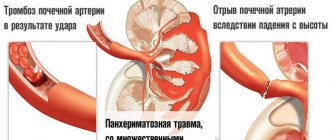Pulmonary hemorrhage: types, treatment
We are talking about a dangerous complication of various pathologies of the respiratory system, which is accompanied by the leakage of blood from the vessels located in the bronchi or lungs and its release.
Characteristic manifestations of the syndrome:
- Cough, which produces blood, liquid scarlet or in the form of clots;
- State of weakness;
- State of dizziness;
- Reduced blood pressure;
- Fainting state.
In order to identify the cause of the syndrome, various diagnostic methods are used, for example, radiography, tomography, bronchoscopy, etc.
To stop the syndrome, various treatment methods are used, including conservative hemostatic therapy and surgical treatment.
The syndrome is typical for lung oncology, as it occurs in half of patients.
The intensity of the syndrome varies: its severity is estimated from 600 ml to more than a liter of blood loss per day.
Kinds
It is important to see the difference between the two concepts “pulmonary hemorrhage” and “hemoptysis”. The latter is less dangerous, it is characterized by a lower volume and rate of blood release, but it can often precede bleeding. Therefore, the importance of its treatment is undeniable.
The classification, which has been used since 1990, distinguishes three degrees of bleeding:
- The first stage is daily blood loss from 50 to 100 ml;
- The second stage is daily blood loss from 100 to 500 ml;
- The third stage is daily blood loss of more than 500 ml.
The condition of heavy bleeding, which occurs simultaneously or over a short period, is extremely dangerous. So, in a severe form of the syndrome, the immediate blood loss can be more than 100 ml.
The difference between “hemoptysis” and “pulmonary hemorrhage” is also important because the first does not frighten the oncologist, he simply makes adjustments to the treatment, while the second requires urgent help, often resuscitation.
Pulmonary hemorrhage: causes, symptoms, diagnosis, treatment
Oncological hospital in Moscow / Pulmonary hemorrhage
Cancer treatment at the Moscow Oncology Hospital
Pulmonary hemorrhage is the leakage of blood of bronchial or pulmonary origin due to damage to their vessels.
In oncology, it is a common sign of lung cancer. Depending on the location of the lesion, bleeding from the lungs occurs at different stages in two to six patients out of ten.
Cause of pulmonary hemorrhage
The main reason is the destruction of the bronchial wall and the vessels in it by the tumor. Through the opened defect in the vessel, blood enters the bronchus, causes a cough reflex and is thrown out.
The intensity of bleeding depends on the caliber of the vessel and the size of the defect formed in it, which cannot shrink on its own due to the rigidity of the vascular wall riddled with the tumor.
Risk of pulmonary hemorrhage
Bleeding can manifest itself in the form of hemoptysis, when no more than 50 ml is released with sputum during coughing per day. It can last long enough without threatening the patient’s life.
The clinical picture and prognosis are different for more massive bleeding, which often becomes fatal. Since their outcome depends more on the rate of blood flow, of the many classifications, the most relevant is the following:
- I Art. – from 50 to 500 ml are released per day. As the volume of blood loss increases, they speak of the first “A”, “B”, or “C” degree;
- II Art. – from 30 to 500 ml of blood is released per hour. Subparagraphs “A” and “B” are also provided;
- III Art. – immediate loss of 100 ml or more, when blood flows “a mouthful”.
Eight out of ten bleedings correspond to the first degree, and their prognosis is more favorable; the remaining patients die in the first hour in 75% of cases.
Even if such lightning bleeding occurs in a specialized department where there is intensive care, thoracic and endovascular surgeons, only one patient out of ten can be saved.
Death occurs not from acute blood loss, but from asphyxia - blood fills the alveoli of the lungs, in which gas exchange occurs, and the patient literally chokes on his own blood.
Signs of pulmonary hemorrhage
Pulmonary hemorrhage often begins without exercise or any other provocation.
A severe cough appears, first dry, and then with bloody sputum.
Often the blood is first scarlet and then darker; it foams when mixed with air.
Increasing blood loss, cardiovascular and respiratory failure cause characteristic symptoms:
- pale skin covered with cold, sticky sweat;
- cyanosis and coldness of the distal extremities, lips, tip of the nose;
- decrease in blood pressure;
- vomit;
- increased heart rate;
- dyspnea;
- tinnitus, darkening of the eyes up to blindness;
- loss of consciousness;
- convulsions.
Diagnosis of pulmonary hemorrhage
Diagnosis of this severe complication is carried out on an emergency basis, almost in parallel with the provision of assistance in intensive care conditions, since minutes often count.
First of all, other sources of bleeding are excluded - from the upper respiratory tract and stomach. Therefore, the patient is examined by an ENT doctor.
Gastric bleeding is characterized by black liquid stools and an acidic reaction of the released bloody masses.
True, with pulmonary hemorrhage, the patient can swallow blood, which is then expelled through vomiting.
Therefore, examinations of the lungs are very important, especially to establish the direct source of bleeding:
- X-ray of the lungs reveals it in half of the cases;
- contrast-enhanced computed tomography allows you to detect a bleeding vessel in three out of four cases, as well as evaluate the bronchial vessels and the entire pulmonary circulation as a whole;
- bronchoscopy serves not only to clarify diagnostic issues, but also to carry out therapeutic endoscopic measures.
Treatment of pulmonary hemorrhage
The priority goals in the treatment of pulmonary hemorrhage are arranged as follows:
- prevention or control of asphyxia;
- stopping bleeding;
- treatment of the disease that caused the bleeding.
Depending on the clinical situation, temporary or definitive methods may be used.
Temporary measures may be final under certain circumstances. This is a complex complex that includes therapeutic and/or surgical measures depending on the severity of bleeding:
- artificial controlled reduction in blood pressure;
- correction of the blood coagulation system;
- drugs that suppress the cough reflex;
- tracheal intubation under anesthesia, aspiration of blood from the respiratory tract;
- artificial ventilation;
- endoscopic coagulation of a damaged vessel or various options for its mechanical compression;
- embolization of bronchial arteries.
Radical treatment of patients is often impossible, since in most cases pulmonary hemorrhage develops against the background of a long history of the disease, when the patient has already undergone surgery and received other treatment. But, when possible, they perform different options for resection of the affected lung or completely remove it.
There is hope for salvation in case of pulmonary hemorrhage only in patients of a specialized department, which has an appropriately equipped intensive care unit, operating room, X-ray operating room, as well as a staff of experienced resuscitators, thoracic, vascular and endovascular surgeons. These are the conditions created in the European Clinic.
Contact us
Causes
The causes of the syndrome are often associated with cancer - tumors of the bronchi and lungs. Sometimes the cause is secondary damage to the bronchi and lungs by metastases from other organs.
The cause of bleeding in oncology is a vessel corroded by atypical cells. The tumor disrupts the normal functioning of the vascular wall of the bronchi, it becomes inelastic and blood begins to flow out of it. That is, there is a connection between the size of the vessel defect and the intensity of bleeding.
Most of the bleeding occurs in the first stage of the syndrome. If lightning bleeding occurs, it is extremely difficult to save a person: two thirds of patients die within the first hour if help is not provided.
2. Reasons
In the vast majority of cases (more than 60%), pulmonary hemorrhage develops when the vascular walls are destroyed by Koch's Mycobacterium in the destructive stage of tuberculosis. However, this is far from the only possible scenario for the development of such massive hemorrhage. Pulmonary hemorrhages can occur with a number of other diseases accompanied by tissue destruction, in particular with:
- acute purulent inflammations, abscessing or phlegmonous-necrotic (anaerobic gangrene);
- germination of a malignant tumor;
- parasitosis;
- pneumoconiosis;
- injuries, splintered rib fractures, foreign bodies;
- rupture of aortic aneurysm and/or pulmonary embolism (PE);
- cardiosclerosis, myocardial infarction and other severe pathologies of the cardiovascular system;
- hypofunction or failure of the blood coagulation system.
A small proportion of cases account for rare, but no less dangerous diseases (Goodpasture, Randu-Osler, Wegener syndromes, diapedesis, hemosiderosis, etc.).
Risk factors include immediate physical or psycho-emotional overload, hypertension or symptomatic arterial hypertension, acute circulatory disorders, severe infections, and thoracic surgical interventions.
Visit our Thoracic Surgery page
Symptoms
Medical practice shows that the syndrome is usually preceded by a severe cough. At first it is dry, then mucous sputum and blood admixtures are observed. As we have already said, the blood can be scarlet or in the form of clots.
In some cases, the precursors of the syndrome are:
- A tickling or gurgling sensation in the throat;
- Burning in the chest.
The general condition of the patient largely depends on how the blood loss is expressed. It could be:
- Fright;
- State of sudden loss of strength;
- Pallor;
- Sweating;
- Reduced blood pressure;
- Cardiopalmus;
- Feeling dizzy;
- Shortness of breath, etc.
If the syndrome is classified as profuse, the following may occur:
Coughing up bloody mucus
- State of fainting;
- Vomit;
- Convulsive state;
- Visual impairment;
- Asphyxia.
Reasons for the development of the disease
The main factor provoking the occurrence of pathology is considered to be traumatic injury to the chest, accompanied by internal bleeding. But the disease often develops in the absence of injury. Other provoking factors include:
- oncological tumors of the lung or pleura;
- aneurysms of large blood vessels;
- pulmonary tuberculosis;
- abscess in the chest area;
- hemorrhagic diathesis;
- coagulopathy;
- complications after surgical operations on the chest organs.
Diagnostics
To determine the syndrome, an examination by an ENT specialist is necessary. That is, it is necessary to understand the nature of the bleeding, because its causes can be not only the lungs, but also the mucous membrane and the stomach.
Main types of diagnostic tests:
- X-ray;
- Computed tomography using contrast.
If it is impossible to find the source of bleeding, bronchoscopy is performed. The method can also be used as a therapeutic method, especially when there is a threat to the patient’s life.
Angiography is another diagnostic method. It is often resorted to when the syndrome is minor and its source has been identified.
Treatment of pulmonary hemorrhage
Since half of the patients, by the time pulmonary hemorrhage developed, had already undergone treatment for primary lung cancer and entered a period of its steady progression, such radical measures to treat bleeding as removing part or all of the lung are impossible for them. Of course, if pulmonary bleeding is the first signal of the presence of a malignant tumor of the lung or bronchus, it is necessary to decide on the possibility of radical surgery if other conservative methods fail to stop the bleeding. A planned operation has undeniable advantages; urgent intervention is aimed at saving lives.
In case of minor bleeding, conservative therapy is first resorted to, with the prescription of antitussive drugs. In case of significant bleeding, interventional endoscopy methods come to the fore, but first the patient is put into anesthesia and the trachea is intubated. During bronchoscopy, the source of bleeding is affected, if one is found, and before that the bronchi are washed with cold solutions and hemostatic agents are administered.
The damaged vessel is coagulated or a balloon or tampon is placed in the bronchus for 1-2 days. Electrocoagulation, laser photocoagulation and argon plasma coagulation of the damaged vessel are possible. In the absence of information about the exact location of the source of bleeding, embolization of the bronchial arteries is performed. Specialized departments have access to a multimodal approach, when coagulation and endoprosthetics are performed, and after stopping bleeding on the tumor, photodynamic therapy and brachytherapy are performed. This approach gives the highest long-term survival.
Modern medical science offers a choice - it depends on the capabilities of the particular institution to which the patient is sent.
Book a consultation 24 hours a day
+7+7+78
Treatment
In the treatment of the syndrome, therapeutic methods, hemostasis, and surgical operations are applicable.
Therapy is prescribed for the syndrome classified as the first two stages.
Aspiration is necessary to remove blood from the tracheal lumen. If we are talking about asphyxia, then urgent intubation, blood suction and artificial ventilation of the lungs are necessary.
Among the medications, hemostatic drugs and antihypertensive drugs are prescribed.
If therapeutic methods do not give a positive result, the syndrome is stopped through local endoscopic hemostasis.
As a rule, these methods help to stop the development of the syndrome for some time.
Palliative surgery is used in cases where it is impossible to perform radical surgery.
As for radical operations, they are aimed at partial resection of the lung, for example, marginal resection or removal of the entire organ.
4.Treatment
Obviously, the strategy and tactics of care are determined by the diagnosed (or most likely, taking into account clinical data) causes of bleeding.
It is not possible to list or describe at least the main options for conservative and/or surgical treatment. However, in all cases, the primary task is hemostasis (stopping bleeding), stabilization of basic vital signs (blood pressure, heart rate, respiratory rate), elimination of the root cause and/or relief of exacerbation of the underlying disease, blood replacement according to indications, decisive measures to prevent severe complications, the likelihood of which given these conditions circumstances is very high.
Diagnosis and treatment of hemothorax
Before prescribing therapeutic measures, the pulmonologist must make a diagnosis. To do this, the patient is interviewed and examined, then he is sent for an instrumental examination. These are radiography, ultrasound of the chest, CT, MRI, endoscopy. Laboratory tests are also required: analysis of sputum, blood contained in the pleural cavity.
After the diagnosis has been made, the doctor prescribes treatment. It can be conservative or surgical. Drug treatment is prescribed for initial or moderate severity of the disease. Therapy includes:
- cardiovascular drugs;
- immunomodulators;
- proteolytic agents.
Treatment of severe hemothorax is more complex. The patient is sent to the surgical department, where he undergoes surgery. During this procedure, the pleural cavity is drained and cleansed of accumulated blood. This is a minimally invasive treatment method. If there is significant damage to the chest with an abundance of wounds, it is opened and the affected areas are sutured. After the operation, stitches are placed and covered with an antiseptic bandage. The patient is also prescribed:
- oxygen therapy;
- intravenous administration of a solution of ascorbic acid and glucose;
- cervical novocaine blockade to relieve severe attacks of pain.
The pathology is dangerous for humans; treatment cannot be delayed. You need to visit a medical facility as soon as possible. The medical department employs highly qualified doctors. The clinic is equipped with modern equipment. This allows you to quickly and accurately make a diagnosis and prescribe treatment.
Clinical picture
- difficult breathing;
- dull pain that intensifies when taking a deep breath or moving;
- decrease in blood pressure levels;
- arrhythmia, increased heart rate;
- deterioration of general health (dizziness, migraine attacks, in severe cases – fainting);
- copious discharge of sputum mixed with blood;
- sharp chest pain that occurs when you touch the affected area;
- mobility of the ribs (in case of traumatic injury to the chest);
- the formation of numerous local hematomas;
- signs of intoxication of the body (occur if the pathology is complicated by the addition of an infection);
- pale skin;
- hyperhidrosis;
- hypothermia.
Emergency care algorithm for pulmonary hemorrhage
Pulmonary hemorrhage that occurs in a person requires emergency care, as it is life-threatening. Therefore, if a similar condition is observed in a person nearby, then, first of all, it is necessary to call an ambulance.
Before her arrival, you need to follow the following algorithm of actions:
- The person should be seated in such a way that his body is slightly tilted forward and his head is not thrown back. This will avoid asphyxia and prevent him from choking on blood.
- If it is not possible to sit the patient down, then he is placed on the side on which the lung is damaged. This is important to do in order to compress it in the chest, thereby reducing blood loss. In addition, this method of laying out will not allow blood to flow into a healthy lung. It is important that your head is always turned to the side.
- You should place a heating pad or ice pack on your chest. If this is not available, you can replace it with any other similar item, for example, a bottle of cold water. This event will allow you to spasm small vessels and slightly reduce blood loss. The cold should be applied for 15 minutes, with a break of 2 minutes.
- The patient needs to be reassured and should not be allowed to talk. In such a state, a person needs absolute physical rest.
- You should not give water to a person with pulmonary hemorrhage.
As for medications, they can only be used after consultation with a doctor. However, it is not always possible to obtain it, so in extreme cases you can independently use a drug such as Vikasol. It is administered intramuscularly and helps stop bleeding. Dition is used for the same purpose, but this remedy requires dilution with saline and intravenous administration. For convulsions, Seduxen or Diazepam is administered, and Promedol or Fentanyl is administered to relieve pain.







